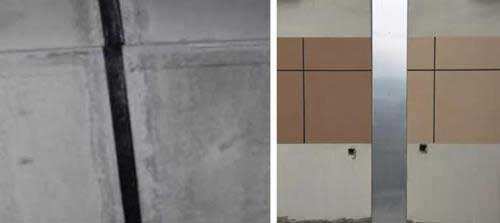Settlement joints refer to vertical joints set up to prevent damage to the house due to uneven settlement of the foundation in various parts of the building. It is generally set at the turning point of the building plane, at the place where the height and load of the building are greatly different, at the appropriate part of the building that is too long, etc. Its width is related to the foundation condition and the building height, generally 20 to 30mm, and it is five to five on the weak foundation. For buildings above the first floor, the joint width should be appropriately increased.
When leakage occurs in basement settlement joints, grouting on the back surface is currently a more effective method of plugging leaks.
1) Determine the location for grouting holes. The grouting holes should be arranged crosswise along the entire settlement joint, and the spacing should be 500mm~1000mm.
2) Clean the settlement joints to avoid damaging the original waterstop in the deformation joints, clean the inside of the settlement joints, and use high-pressure water guns to flush them if necessary.
3) When laying holes at both ends of the settlement joint, the original waterstop should be avoided. Do not penetrate the waterstop when laying holes to cause damage to the waterstop.
4) When the water pressure is high, the quick-setting leak sealing agent must be filled into the joint first. When there is no longer a large amount of water pouring out, water-soluble polyurethane should be poured into the outside of the waterstop.
5) After the outer pouring is completed, water-soluble polyurethane is poured into the inner side of the settlement joint so that the waterstop in the settlement joint is completely wrapped in the water-soluble polyurethane water-stop agent.
6) Then fill the inside of the settlement joint with water-swelling waterstop strips so that the waterstop strips are densely embedded in the cracks. The outside of the waterstop strips is filled with leak-proofing material. Among them, the concrete surface on the inside of the settlement joints that is in contact with the waterstop strips It should be repaired and smoothed.
7) In order to prevent the structural settlement joints from deforming again in the later stage, two-component polysulfide elastic sealant is used to fill the inside of the deformation joints to resist the later settlement deformation of the structure.
8) After the construction of the above waterproof layer is completed, after a period of observation, it is confirmed that the waterproof layer has a waterproof effect. On the outside of the structural deformation joint, rubber waterstops are attached to the outside of the structural deformation joints (the waterstops are on the base layer on both sides of the settlement joints). The width of the joint should not be less than 100mm), as the last line of defense, and fix it with a steel plate, and then restore the decorative gussets on the outside of the deformation joint, etc.
9)For the local and trace leakage water left after the deformation joint leakage control, auxiliary drainage measures such as drainage channels and drainage ditches can be used. The drainage tank should be made of stainless steel or plastic and should be connected to the drainage system. The drainage should be smooth and the drainage flow should be greater than the leakage amount. Drainage ditches can use open ditch drainage or buried pipe drainage to guide water into the collection well.
